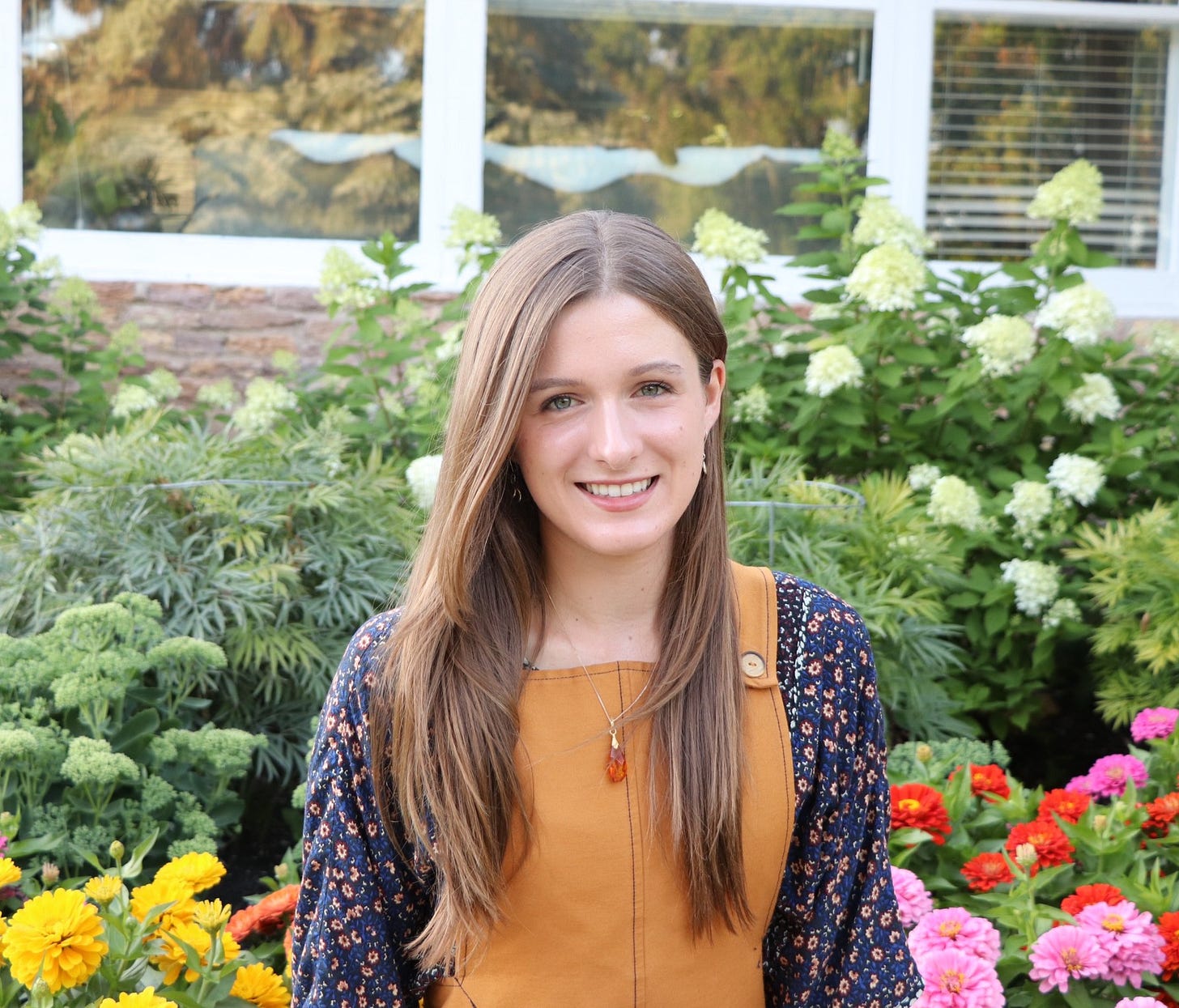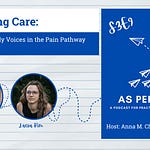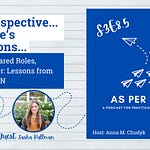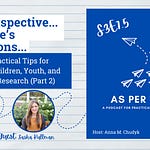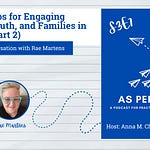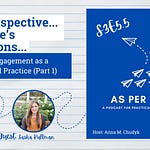Episode summary
In this onePERspective episode of asPERusual, doctoral trainee Sasha Kullman provides her key takeaways on Season 3, Episode 4, which featured Angie Hamson discussing the roles of professional patient partners in engaging children, youth, and families in quality improvement and governance.
Drawing on her own experience as a student researcher engaging directly with youth, Sasha explores three key takeaways from Angie’s story:
The importance of who facilitates engagement — why roles like “patient partner in residence” are especially powerful because they are filled by someone with lived experience.
The need to integrate engagement into research culture — and how dedicated roles can help organizations move from tokenism to meaningful partnership.
The centrality of trust — including why patient and family partners shouldn’t have to share their full stories to be seen as credible contributors.
Sasha closes with a thoughtful question: How can we build research spaces where patient and family partners feel welcomed, respected, and trusted—whether or not they disclose their personal stories?
Whether you're new to patient engagement or deeply immersed in it, this short episode offers a reflective and practical lens on what it means to foster truly collaborative research environments.
Meet our guest listener
Sasha Kullman: Sasha is a PhD student in the College of Pharmacy at the University of Manitoba, supervised by Dr. Anna Chudyk. She holds a master’s degree from the Faculty of Kinesiology and Recreation Management at the same institution, where her research focused on health psychology, health promotion, and patient engagement in research. Funded by a CIHR Canada Graduate Scholarship, Sasha’s doctoral work continues to center on participatory approaches, involving patients and their families in research designed to enhance healthcare experiences.
Episode Transcript:
Anna Chudyk:
Hi everyone! Welcome to onePERspective — a bi-weekly segment where a featured guest shares their key reflections on the latest episode of asPERusual, my podcast all about practical patient engagement in research. I’m your host, Anna Chudyk.
Joining me again today is Sasha Kullman, a doctoral trainee in my lab. Sasha, I’m really looking forward to hearing your thoughts on Season 4, Episode 4 of asPERusual, which is all about the roles of professional patient partners in engaging children, youth, and families in quality improvement and governance.
Sasha Kullman:
Hi everyone! I’m Sasha, a doctoral student in the College of Pharmacy at the University of Manitoba. As Anna mentioned, my research involves patient engagement, and I’ll be working directly with youth as part of that process.
One of my personal learning goals is to grow as a facilitator of meaningful patient engagement. I want to make sure that the voices and priorities of patients and families truly shape and guide my work in health research. That’s why I’m really happy and grateful to be a part of this podcast.
In the last episode of asPERusual, we heard from Angie Hamson, a parent of a medically complex child who became a leader in child, youth, and family engagement. Angie shared how she moved from personal experience to professional roles on advisory boards, nonprofits, and health system teams.
Angie also explained what it looked like to bring lived experience into roles like “patient partner in residence,” and why that matters. She also discussed how organizations can move beyond tokenism and meaningfully include families in decision-making.
Today, I’d like to share three takeaways I’ve been reflecting on since listening to the episode.
My first key takeaway relates to Angie’s ability in her role to navigate between the worlds of researchers and patient/family partners.
When Angie discussed being a patient partner in residence at Health Standards Organization, she described this idea of “wearing two hats”—that she could understand and relate to both the research staff and the patients and families she collaborated with. This really stood out to me, because by sharing her own lived/living experience, she was able to foster trusting relationships with patients and families that weren’t extractive, and build stronger rapport with those individuals. As a result, she could help facilitate better connections between the patient/family partners and the research staff too.
In the past, we’ve talked about how having a team member whose role is to facilitate meaningful patient and family engagement can make a big difference in a research project. We often refer to that person as the patient engagement liaison. That’s typically a research team member who has the time and skills to build relationships with patient and family partners. In a lot of projects, that ends up being a student or a research fellow. I’ve taken on that role a few times over the last few years, and I always love it—I find it really meaningful.
But after our conversation with Angie, I’ve been thinking more deeply about who takes on that role. It’s not enough to just have an engagement liaison—the person you put in that role really matters. And where possible, researchers should consider hiring an engagement liaison who is also a patient or family partner. That way, you’re not only ensuring your engagement liaison has the skills and capacity to support meaningful engagement, but they also bring lived expertise—and that makes a big difference in helping other patient and family partners feel seen, heard, and well-represented.
I think that’s something Angie was able to do really well—sharing her own lived/living experience and leveraging it to build rapport and reciprocity with the partners she worked with.
My second key takeaway relates to integrating patient and family engagement as a standard practice
Something Angie said that really stuck with me was the way she helped researchers and clinicians understand the scope of the patient and family partner role—the potential that lies within engagement—and how to engage in ways that feel inclusive and accessible. She did this by drawing from her own lived experience.
When it comes to promoting patient and family engagement in research and governance, one piece of the puzzle seems to be having someone in a dedicated role—like a patient or family partner in residence—who researchers and clinicians can turn to for guidance and support. But another important piece is making sure those researchers and clinicians actually see the value of patient and family engagement, and feel open to applying it in their own work. That way, they’re more likely to approach the patient or family partner in residence with their questions and ideas.
It sounds like Angie was actively helping with that culture shift—offering workshops, building relationships, and creating spaces where researchers and clinicians could learn about the value of the patient voice and feel comfortable reaching out for support.
She also really drove home the importance of patient and family engagement when she said that an organization is failing if it only evaluates how a service is delivered—and not how it is received. That felt like such a powerful statement. It highlights how the patient voice offers a perspective that’s not only unique, but complementary to the insights of researchers, clinicians, and decision-makers.
As Angie described, yes—efficiency and effectiveness are important. But you can’t approach health services with an assembly line mindset. Patients are real people with real experiences, agency, and preferences. Just because something works well for a care provider or a healthcare organization, doesn’t mean it feels acceptable—or even functional—for the patient.
That’s exactly why it’s so important to have multiple patient and family voices at the table when decisions are being made about the systems and services that affect them most.
My third key takeaway is around trust
In last week’s episode, Angie talked about how patient and family partners bring experience and expertise that you’ll never find on a resume—experience that’s hard-earned and absolutely deserving of the same respect we give to degrees or credentials.
But she also made a really important point: patient and family partners should never have to disclose their whole stories in order to share their perspectives. Some experiences don’t need to be written out, and they don’t need to be spoken out loud either.
To me, that speaks to the balance between working with partners who do have relevant lived experience—if that’s important to the project—without ever pressuring someone to share more than they’re comfortable with.
At the heart of that, I think, is trust. If a patient or family partner says, “Yes, I have the lived or living experience to contribute meaningfully to this work,” that should be enough. No extra questions unless they’re directly relevant to the project. You might hear more about a patient/family partner’s story over time as you build a relationship, and in those cases, the privilege of hearing those details has been earned.
In academic spaces, we’re often expected to “prove ourselves” with our credentials and experiences to show we’re a good fit for something. But we need to be careful not to bring that same pressure into our engagement work—because relationships built on mutual respect, inclusion, and support shouldn’t require anyone to “prove themselves” to have a seat at the table.
If we think back to experiences in our own lives, whether you are a researcher or patient/family partner listening, I think many of us have had that experience—feeling like we had to justify our place, even with people who were supposed to be equals. And that feeling? It erodes trust. It makes it harder to build the kind of collaborative relationships we’re striving for.
Points to Ponder
So I want to leave us with a point to ponder—something I’ll be thinking about, too:
How can we create research environments where patient and family partners know they’re welcomed, trusted, and respected — with or without sharing their full stories?
How do we build spaces where sharing perspectives is enough, and where the relationship is collaborative, not extractive?
And I think a good place to start... is by asking our patient and family partners.
Anna:
Thanks so much, Sasha! I completely agree. The only way to create meaningful experiences with patient and family partners is to actually do it with them. That includes co-creating environments that feel welcoming, respectful, and collaborative. What works for one person won’t necessarily work for another — and the same goes for entire groups and teams. So the best way to unpack these questions is through open dialogue with your own patient and family partners.
In the next full episode of asPERusual, I sit down with Rae Martens, a knowledge broker, disability advocate, and bereaved parent, to explore how engagement in research is a deeply psychosocial and evolving practice — for both patient partners and researchers. We talk about the emotional labour of engagement, the importance of creating emotionally accessible spaces, and Rae’s work with the Family Engagement in Research (FER) program at McMaster University. Together, we unpack what it means to build authentic partnerships, how the Family Engagement in Research program’s micro-credential courses support relationship-centred research. Whether you’re new to patient engagement in research or a seasoned collaborator, this episode offers rich insights into the heart of engagement.
As always please be sure to head over to our website at asperusual.substack.com where you can find previous episodes, check out interactive transcripts, and subscribe to our newsletter. And if you haven’t already, please subscribe to the podcast, and leave a positive review, wherever you like to listen — it really helps others find us too.
You can always reach me directly at anna.asperusual@gmail.com, or connect with me on LinkedIn by searching for Anna M. Chudyk — that’s C-H-U-D-Y-K. You can add Sasha to LinkedIn my searching for Sasha Kullman - K-U-L-L-M-A-N.
Thanks again for listening — and until next time, let’s keep working together to make patient engagement the standard… or asPERusual.




